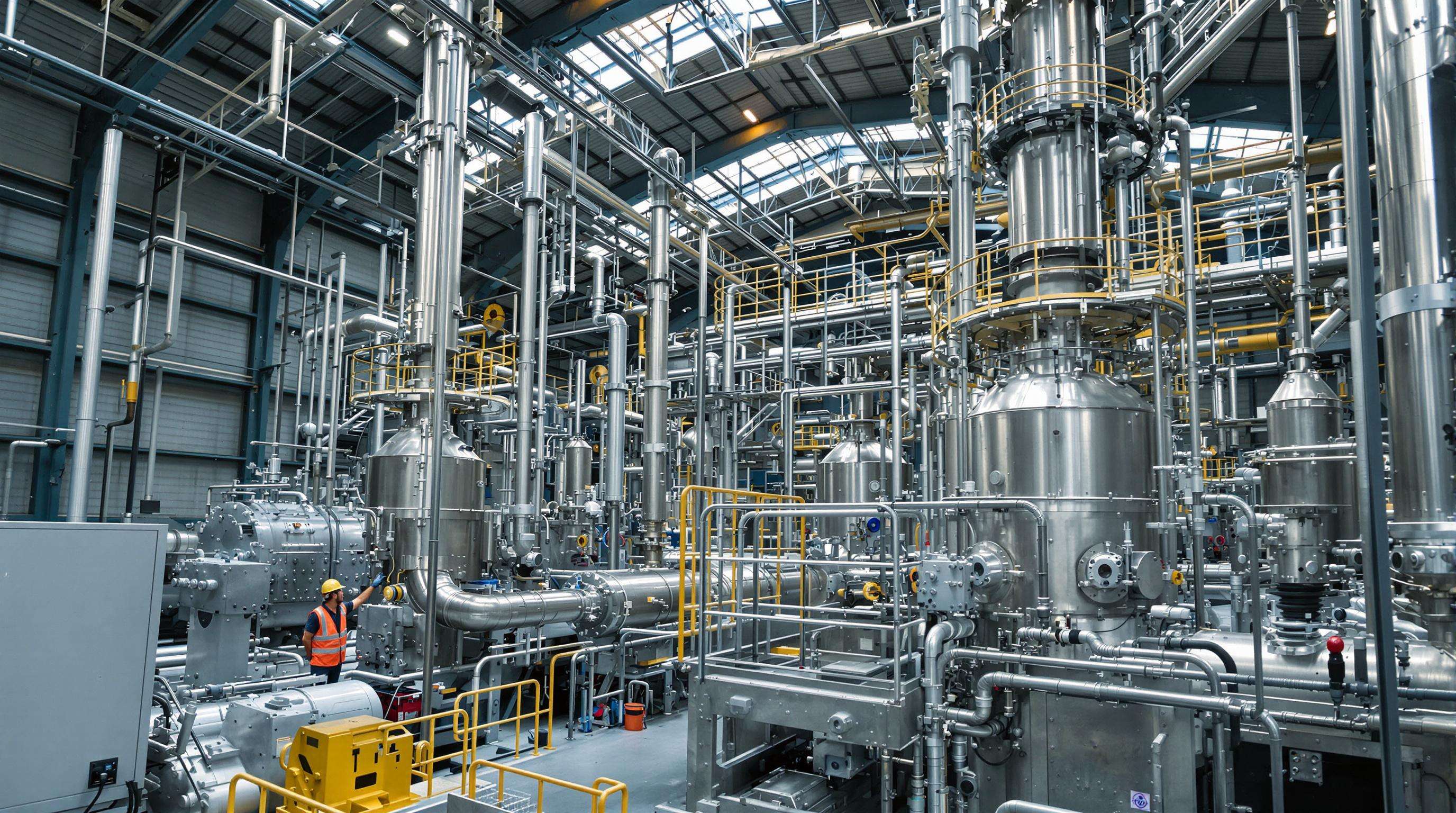Refineries around the world are getting looked at more closely than ever before because governments keep making their carbon rules stricter. Take the EU Emissions Trading System for example it's now hitting companies with penalties over $110 per metric ton if they go over their CO2 limits. And then there's Euro VI regulations that want refineries to cut down on tiny particles in the air by almost 30% by 2025 compared to where things stood back in 2020 according to ICCT research from last year. These kinds of regulations aren't just happening in Europe though. About a quarter of US states have basically copied California's Low Carbon Fuel Standard program. Meanwhile across the Pacific, China has rolled out its own National Carbon Market system that includes roughly 2,200 different industrial facilities, many of which process crude oil through cracking operations.
Fluid catalytic cracking (FCC) units are responsible for roughly 40 to 60 percent of a refinery's carbon footprint because these operations require so much energy for their thermal processes plus all those catalyst regeneration cycles. According to recent research from the Materials & Energy Balance Study published in 2024, modernizing old cracking systems might actually slash Scope 1 emissions by around 34% for every barrel that gets processed through them. There are several areas where improvements can make a real difference. For starters, adjusting reactor temperatures properly helps prevent excessive coking, which alone saves between 12 and 18% on fuel gas consumption. Another big win comes from installing waste heat recovery systems that significantly lower steam requirements by about 25%. And let's not forget about switching to feedstocks derived from biomass materials. This change alone cuts down lifecycle emissions by nearly half at 52%, making it one of the most impactful strategies available today.
A consortium of Rhine-Ruhr refiners achieved 22% emission reductions across six cracking units in 2023 through phased interventions:
| Phase | Action | Result |
|---|---|---|
| 1 | Retrofit wet gas scrubbers | 38% lower SOâ |
| 2 | Install electrostatic precipitators | 94% PM2.5 capture |
| 3 | CCS pilot on FCC flue gas | 15,000 tons COâ/year sequestered |
The project’s $740M capital outlay delivered $210M/year in avoided carbon fees and productivity gains, demonstrating compliance’s business case.
Operators who want to stay ahead are connecting their emission control strategies with ESG standards that put carbon intensity at the forefront. According to the Energy Institute's latest 2024 recommendations, companies should integrate real time emissions tracking directly into their daily operation screens. Some firms have even started linking around a third of top management bonuses to how well they hit those decarbonization targets. This approach addresses what investors care about most these days when it comes to environmental reporting, but there's another angle too. Companies that adopt these practices now are better positioned when carbon prices keep going up, something many experts predict will happen over the next few years as governments tighten regulations on greenhouse gases.

Hydrocracking today runs about 15 to 20 percent cooler than traditional approaches, typically between 300 and 400 degrees Celsius. This drop in temperature means less energy is needed overall, yet still keeps production levels strong. Fluid catalytic cracking units have also seen improvements lately, with new regenerator designs making combustion much more efficient. These changes help cut down on carbon dioxide emissions by around 12 to 18 percent for each processing cycle. When it comes to catalysts, silica-alumina versions are showing real promise too. They boost hydrocarbon conversion rates by roughly 25% over what was possible before according to research published by Mizuno and colleagues back in 2023. Such advancements make it easier for refineries to meet requirements under the European Union's Emissions Trading System as well.
Catalyst innovation is critical for decarbonization. Nanostructured zeolites doped with rare earth metals enhance cracking efficiency, enabling 30â40% faster reaction kinetics. Selective catalysts now prioritize olefin production while minimizing coke formationâa major source of direct emissionsâachieving 10â15% higher product selectivity and reducing reprocessing needs and associated energy waste.
In late 2023, a refinery near Hamburg ran tests on cobalt modified FCC catalysts right there in their actual production environment. After about half a year, they saw CO2 emissions drop somewhere between 18 and 22 percent when compared against what they were getting from regular old catalysts. The best part? Diesel production stayed exactly the same during all this time. What happened was that these new catalysts spread out the metal better across surfaces, which made those hydrogen transfer reactions work much harder. Less fuel gas ended up going up in smoke too. All told, this meant around 2.7 million euros saved every year just from buying fewer EU carbon credits. So here we have proof that going green doesn't always mean spending more money.

CCUS systems play a major role in cutting down CO₂ emissions from oil refineries, especially when it comes to those cracking units. Basically, these systems grab the emissions right where they're produced, squeeze them into a transportable form, and send them off to places like deep underground saltwater reservoirs for long term storage. The UK Climate Change Committee reported last year that if industries get serious about adopting CCUS technology, we might see around half of all refinery emissions disappear by 2035. Let's put this into perspective: cracking units take those thick, heavy hydrocarbons and turn them into lighter fuels that people actually want to buy. These particular parts of refineries contribute between 15% to 25% of total carbon output, so no wonder they're high on the list when companies look at retrofitting their facilities with carbon capture solutions.
Fluid catalytic cracking (FCC) units that turn heavy gas oils into usable gasoline are starting to incorporate carbon capture and storage (CCS) tech specifically designed for these high temperature, catalyst driven processes. The latest generation of amine based solvents can actually capture around 90 to 95 percent of CO2 emissions while not draining too much extra energy from the system. According to recent research published by Inspenet in 2024, when CCS gets integrated into FCC operations, it cuts down on overall emissions by about 18 to 22 metric tons every single hour. We're also seeing hybrid systems become more popular lately, where post combustion capture methods get combined with oxy fuel combustion techniques. These mixed approaches tend to work best in areas where carbon prices have gone above $80 per ton, making the investment more economically viable for plant operators looking to cut their environmental footprint.
CCS definitely has environmental advantages, but getting it adopted widely hinges on bringing down those costs and lining up supportive policies. Right now, implementing CCS adds around $12 to $18 for each barrel of refined oil, and most of that expense comes from building out storage facilities and transportation networks. The good news is we're seeing some promising developments. Modular capture systems and shared CO2 pipeline networks are already cutting initial investment requirements by roughly 30 to 40 percent in many cases. Looking at what the UK government outlined in their 2024 CCS strategy, they point out that combining financial incentives like the $85 per ton tax credit with large scale hydrogen production efforts might actually turn CCS projects at refineries into something worth investing in financially as early as 2027.
Modern machine learning systems look at all sorts of data coming out of oil cracking operations these days. They track things like what kind of feedstock is being used, how temperatures change over time, and how well the catalysts are performing before making real time adjustments. Some pretty smart algorithms can actually forecast when the best times will be for cracking processes, usually somewhere between a day and two days ahead. This helps cut down on wasted energy whenever there's a switch from one process to another. According to recent findings from the International Energy Agency, plants that have implemented AI for their cracking units typically save around 12 to maybe even 18 percent on energy costs compared to older methods where people had to manually control everything. That's quite a difference considering how expensive energy has become lately.
Fluid catalytic cracking units now come equipped with IoT sensors that track carbon dioxide levels, heat distribution patterns, and how well the catalysts are performing. These smart systems automatically tweak things like the mix of air and fuel, when steam gets injected, and what temperature reactors run at while operations are happening. Research from last year looking at emissions control through sensors showed something pretty impressive actually those small tweaks can cut down greenhouse gases produced during refining by around twenty percent. For refineries trying to meet environmental standards without sacrificing production, this kind of real time monitoring makes all the difference.
One European refinery recently brought in AI powered predictive controls for their FCC unit, specifically focusing on those energy hungry regeneration cycles. The machine learning systems worked out the best settings for burners and how fast catalysts should circulate, all based on what kind of feedstock was coming through at any given moment. After about 18 months running this setup, they saw a pretty impressive drop in natural gas usage around 15%, which works out to roughly 3.2 MMBtu per barrel processed. What's even better is that they managed to keep cracking efficiency at an amazing 99.2%. This success story shows that similar approaches can work well at scale, especially for larger facilities processing over 200 thousand barrels each day without compromising performance standards.
Strict carbon and emission regulations, such as the EU Emissions Trading System and Euro VI, are compelling refineries to adopt low-emission systems to avoid penalties and ensure compliance.
Cracking systems, particularly Fluid Catalytic Cracking (FCC) units, significantly contribute to a refinery's carbon footprint due to their high energy demands and catalyst regeneration cycles.
Refineries can implement waste heat recovery systems, switch to biomass-derived feedstocks, and adopt CCUS and AI-driven optimizations to effectively reduce emissions.
Financial incentives, modular capture systems, and shared CO2 pipeline networks can help refineries balance cost with sustainability, making CCS adoption more feasible.
 Hot News
Hot News2024-09-25
2024-09-18
2024-09-12
2024-09-05
2024-08-30
2024-08-23

Copyright © 2025 by Shangqiu AOTEWEI environmental protection equipment Co.,LTD Privacy policy